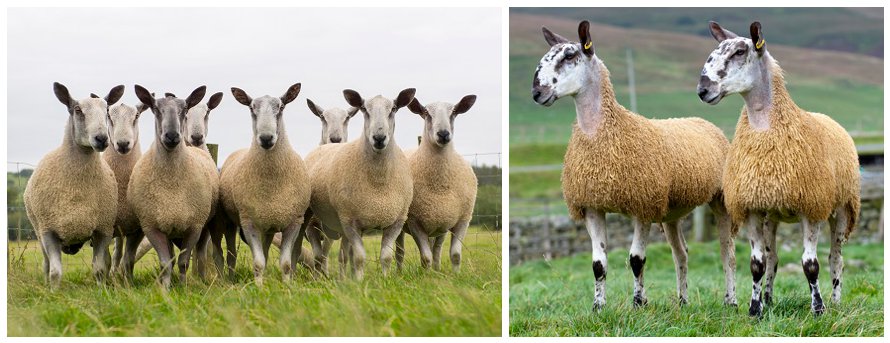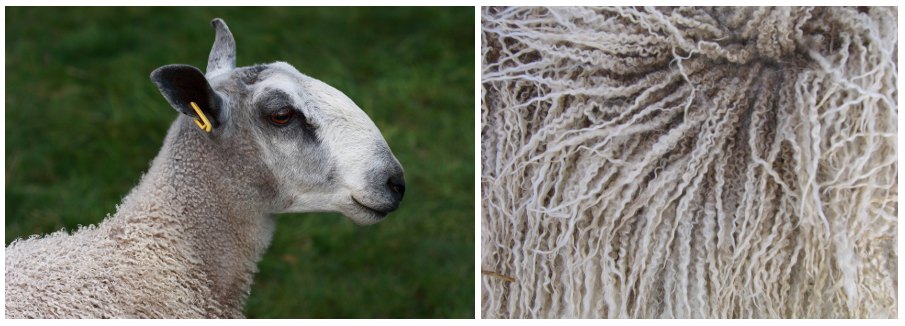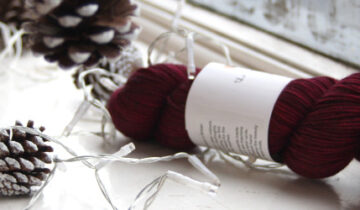Many elements should be taken into account when assessing the quality of a yarn and the most important of all is of course the fleece it is made from. Fleece – or wool – varies from one breed of sheep to another, carrying specific structural elements that impact the softness, strength and drape of the yarn. Knowing about the fleece produced by different breeds of sheep is a good way to understand what to look for when buying wool for a new project. Depending on the effect you want to achieve you might favour certain wool over some others.

1. History
Today we’re going to look at the Blue-faced Leicester, an ancient British breed that has evolved from a breeding scheme designed by Robert Bakewell in the 1750s to improve the Longwool sheep. Originally bred for its wool, the Longwool Sheep had the disadvantage of being small framed, slow maturing and wasn’t prolific at lambing, which made it no good for producing high quantity meat. When Bakewell started his experimentation, major changes occurred in sheep breeding, by increased focus on meat production after wool lost the popularity it had known in the Middle Ages. Through his breeding scheme Bakewell aimed to create a breed that would keep the fleece quality of the Longwool sheep but with higher gains for meat and better capability in producing lambs.
To do so he crossbred the Longwool sheep with Mugs, Old Ryeland and other local breeds, creating the Dishley Leicester, a fast maturing sheep, good producer of meat, with excellent crossbreeding capability and high quality wool. Rapidly the Dishley Leicester became very popular and was used all over the country to improve local breeds as well as creating a new one.
For the next 150 years the Dishley Leicester kept spreading and evolving, giving place to breed like the Border Leicester and later the Bluefaced Leicester who finally appeared at the turn of the 20th century.
Like the Dishley Leicester, the Blue-faced Leicester was originally created as a ‘crossing breed’, but as it grew increasingly popular all over country, farmers started using it solely for the production of meat and wool. Eventually the Bluefaced Leicester Sheep Breeders’ Association was created in 1963, leading to the opening of their first national flock book in 1964. Today it is still one of the most popular British breeds.

2. The Wool.
Like its ancestors the Bluefaced Leicester classified as a long wool sheep. Due to the large diameter (32 to 40 microns) and the structure of their fibre, longwools are strong, hard-wearing and very lustrous, ideal to create heavier knitwear or outer garment. Bluefaced Leicester fleece forms long, narrow, curly locks and present a fibre diameter varying between 28 and 24 microns, which makes it thinner than most longwools. Consequently it is also much softer and silky. Due to those structural properties, the Blue-faced Leicester wool is great to create a yarn both strong and soft, that drapes beautifully once knitted.

3. The Sheep.
Bluefaced Leicester sheep are strongly built, with a broad muzzle, a roman nose and long v-shaped erect ears. The head doesn’t grow any wool, showing the dark blue skin which gave its name to the breed. The ideal Bluefaced Leicester should be white, but some individual sheep have been known to produce mixed black and white, solid black or brown wool. The wool should be dense, fine, tightly curled and semi lustrous with an even, consistent coverage on the body.
4. Yarns.
As previously mentioned BFL wool has the great advantage of being both soft and strong, two qualities very much sought after in hand knitting yarn. Therefore it is not surprising to find it in many wool blends available such as the Signature 4ply by the West Yorkshire Spinners or the BFL Fingering by the Uncommon Thread. With its 35% BFL, the Signature 4ply is an excellent yarn to knit long lasting socks. Similarly the BFL Fingering would allow you to create garments with a beautiful drape, less likely to felt in comparison to something knitted with a softer wool.
We hope you enjoyed this post as within the next few months, we’d like to regularly share similar articles to give you a little more insight into the fascinating world of sheep breeding and yarn making. Please do not hesitate to give us some feedback!
Until Next Time… Happy Knitting!
***
SOURCE:
Fournier, Nola and Fournier, Jane, In Sheep’s Clothing: A Handspinner’s Guide to Wool, Loveland: Interweave Press LLC, 1995. Print
‘Breed Info‘, Bluefaced Leicester Union of North America, Web. http://bflsheep.com/breed-info/
‘Breed Description’, Bluefaced Leicesters: The Vital Piece of the UK Sheep Industry, Web. http://www.blueleicester.co.uk/breed/descriptionnew.html
‘Bluefaced Leicester Top – Bred on Exmoor’ John Arbon Textiles, Web. https://www.jarbon.com/index.php?main_page=product_info&cPath=182_27_91&products_id=296&zenid=t9j3chm6pjldrvhq1kp73f4sn0#.WH97sFOLSM8
‘The Blue-faced Leicester’, Atelier Conquet, Web. http://www.atelierconquet.com/the-blue-faced-leicester/
‘Midlock Bluefaced Leicesters’ Bluefaced Leicester Breeders Association, Web. http://www.blueleicester.co.uk/sales/midlock.htm
‘Bluefaced Leicester Sheep’ Rob Collins, Flickr, Web. https://www.flickr.com/photos/21992619@N05/3050361512



 No products in the basket.
No products in the basket.